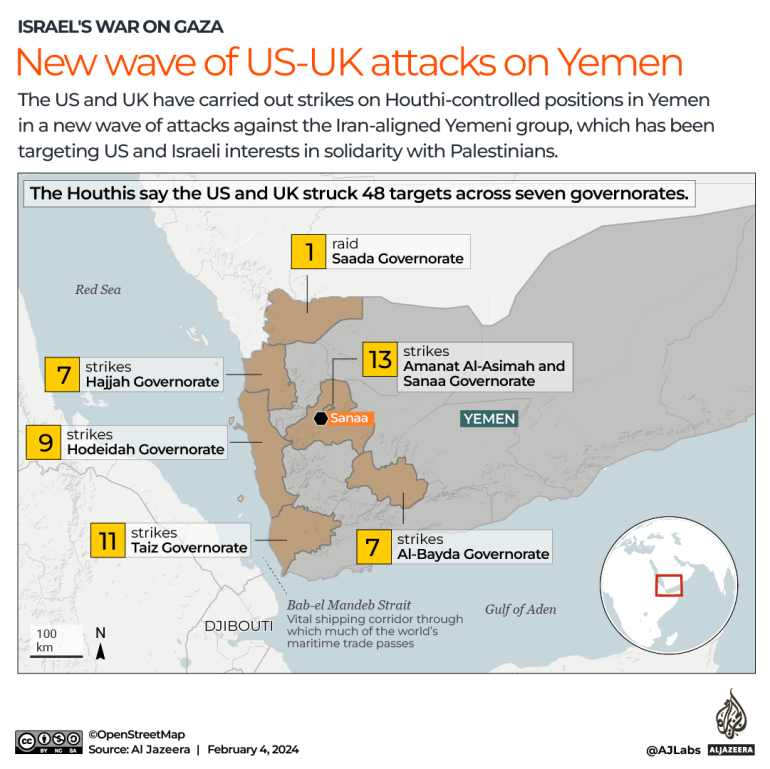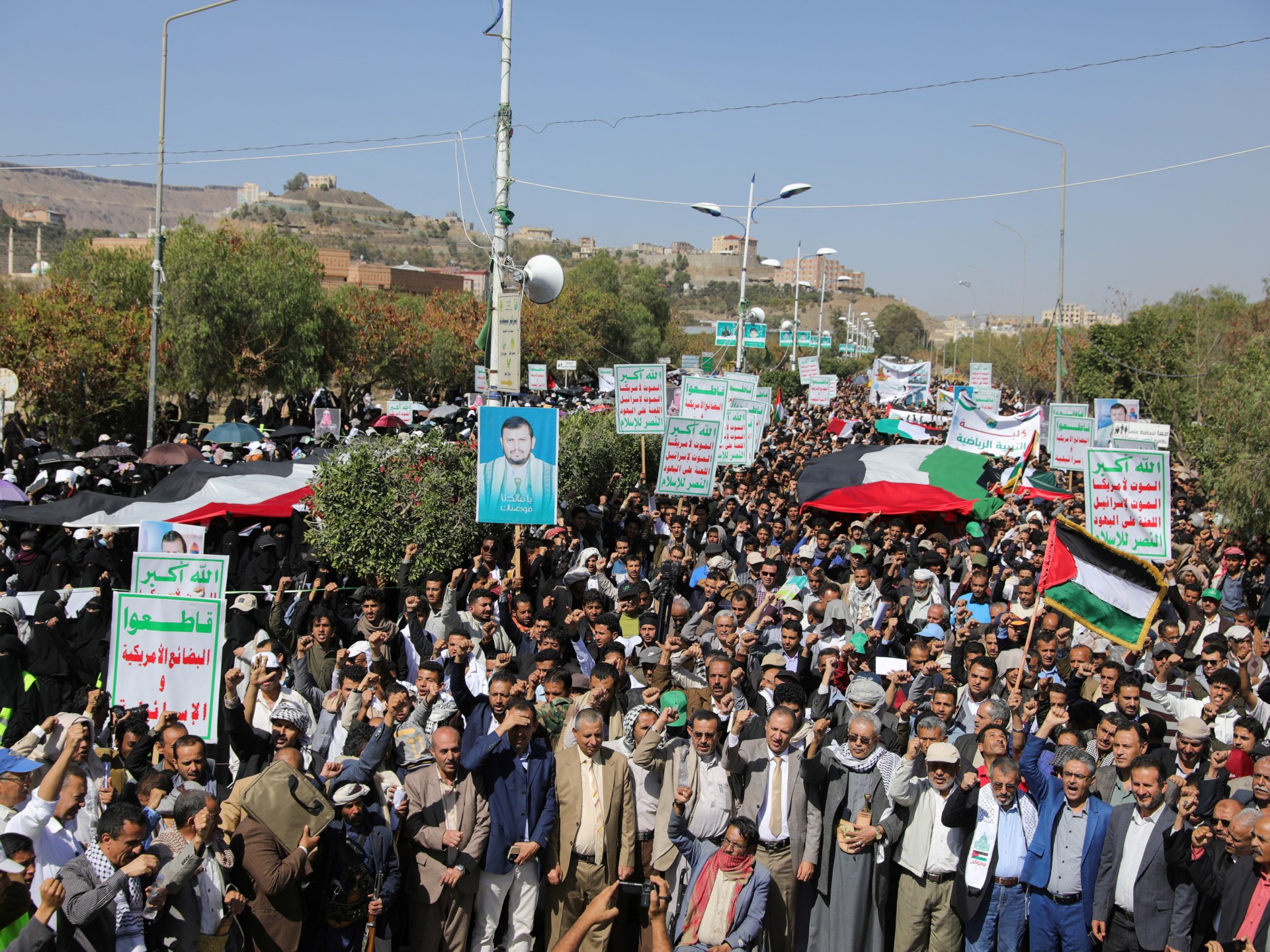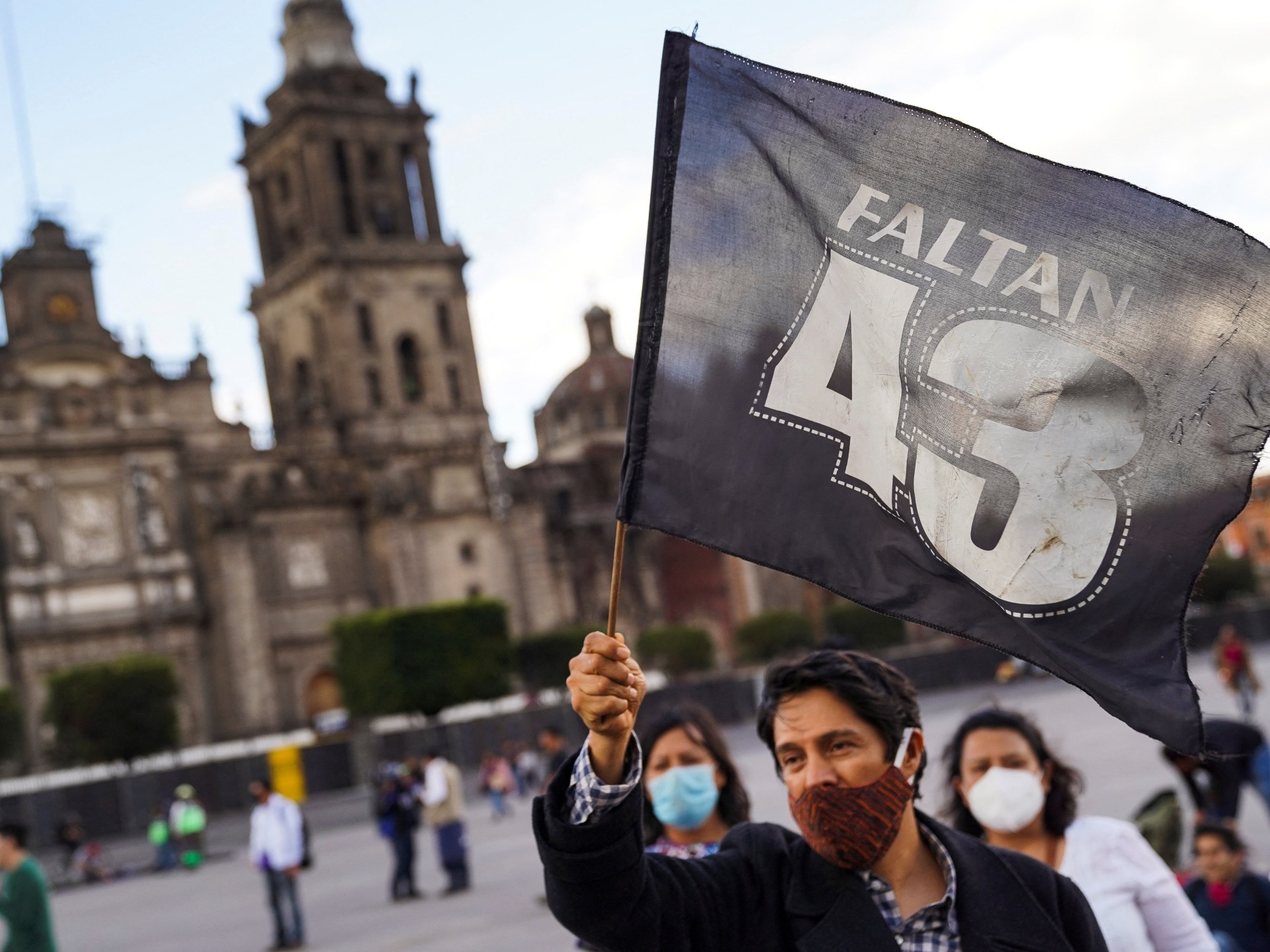Which Houthi targets were hit by US-UK strikes in Yemen?
The Houthi group in Yemen has again vowed that its attacks aimed at stopping Israel’s war on Gaza will not stop after the United States and the United Kingdom launched dozens of strikes overnight on Saturday.
The latest strikes, backed by six other allies, come a day after the US launched dozens of strikes targeting armed groups in Iraq and Syria that Washington said were backed by Iran.
The Houthis initially attacked only Israeli-linked ships in the Red Sea in solidarity with Palestinians, but expanded their attacks to include British and US ships after Washington and London launched strikes in Yemen.
Let’s take a look at which Houthi targets were attacked, what kind of weaponry was used, and how everyone has reacted to it.
Which Houthi targets were attacked?
The US and UK launched a barrage of strikes against Houthi-controlled areas in Yemen on Saturday, February 3. The US Central Command (CENTCOM) said it hit a Houthi antiship missile in the Red Sea on Sunday in a separate attack.
The US and UK said they targeted 36 Houthi positions in Yemen, while Houthi military spokesperson Yahya Saree said the capital, Sanaa, was among the places attacked in Saturday’s strikes. So far there have been no reports of casualties.

The targets included underground storage facilities, command and control centres, missile systems, drone storage and operations sites, radars, and helicopters, according to CENTCOM.
The US military said it hit 36 Houthi targets in 13 locations, but as with many previous strikes on Yemen since the start of the war on Gaza, it refrained from disclosing further details. This was the third large joint operation against the Houthis in two weeks.
The US had also announced strikes on several anti-ship cruise missiles that it said posed a threat to its military vessels and commercial ships travelling through waters near Yemen.
The military of the Yemeni group, also known as Ansarallah, said it was targeted by 48 attacks on multiple governorates, including 13 on Sanaa and surrounding areas, 11 on Taiz, nine on Hodeidah, seven on al-Bayda, seven on Hajjah, and one on Saada. It reported no casualties.
What weapons were used in the Yemen strikes?
The Houthi targets were struck by both fighter jets and military ships of the US military, and fighter aircraft from the British air force.
F/A-18 fighter jets from the USS Dwight D Eisenhower aircraft carrier, British Typhoon FGR4 fighter aircraft, and US Navy destroyers USS Gravely and USS Carney participated in the strikes, according to US officials and UK Defence Ministry authorities cited by the Associated Press.
The US ships fired Tomahawk missiles from the Red Sea, it said.
The strikes come as the Houthis continue to launch missile, drone and boat attacks against Israel-linked commercial vessels and US and UK military ships in the Red Sea and Gulf of Aden almost on a daily basis.
The Houthis say the attacks, which have disrupted global trade, will stop when Israel ceases fire in Gaza.
Who was targeted in Iraq and Syria, and why?
The Yemen strikes happened a day after the US launched strikes in retaliation for the drone attack by the Islamic Resistance in Iraq, a coalition of armed groups linked to Iran, that killed three US soldiers at an outpost in Jordan on January 28.
The US military said its forces struck 85 targets in Syria and Iraq linked to Iran’s Islamic Revolutionary Guard Corps (IRGC) and political and military groups.
Some of the armed groups, which are part of the Iran-backed “axis of resistance”, have carried out dozens of attacks against US interests in the region in the wake of Israel’s brutal war on Gaza. They demand that Israel declare a ceasefire and allow humanitarian aid in the Palestinian enclave facing famine-like conditions. They have also vowed to fight the US military presence in Syria and Iraq and other places, which they consider to be “occupation” of their lands.
Syria’s eastern province of Deir el-Zour and the northeastern province of Hasakeh, where US bases are located, have come under attack for years.
The Euphrates River cuts through Syria into Iraq, with US troops and US-backed Kurdish-led fighters on the east bank and Iran-backed fighters and Syrian government forces to the west.
US bases in Iraq, particularly the Ain al-Assad base, have come under hundreds of attacks over the past few years as well. The base was where the IRGC launched missiles after Washington assassinated its top general Qassem Soleimani in January 2020. The attack left dozens of US soldiers injured, but none killed.
Iran-backed armed groups control the Iraqi side of the border and move freely in and out of Syria, where they man posts with their allies from Lebanon’s powerful Hezbollah and other Shia armed groups. Tehran is the main military backer of Syrian President Bashar al-Assad in the decade-long war.
What was hit in the deadly strikes in Iraq and Syria?
The US military flew in B1 bombers from the US to strike targets in Iraq and Syria.
It said the barrage of strikes hit command and control headquarters, intelligence centres, rockets and missiles, drone and ammunition storage sites, and other facilities connected to the Quds Force, the external operations arm of the IRGC.
Syrian opposition activists said the strikes hit the Imam Ali base near the border Syrian town of Boukamal, the Ein Ali base in Quriya, just south of the strategic town of Mayadeen, and a radar centre on a mountain near the provincial capital that is also called Deir el-Zour.
Rami Abdurrahman, who heads the Britain-based Syrian Observatory for Human Rights, said 29 rank-and-file fighters were killed in those strikes, according to AP. Al Jazeera could not independently verify the casualty figures.
The attacks also hit a border crossing known as Humaydiya, where militia cross back and forth between Iraq and Syria, according to Omar Abu Layla, a Europe-based activist who heads the Deir Ezzor 24 media outlet. He said the strikes also hit an area inside the town of Mayadeen known as “the security quarter.”
Iraqi government spokesperson Bassim al-Awadi said the border strikes killed 16 people and caused “significant damage” to homes and private properties.
The Popular Mobilisation Forces (PMF), a coalition of Iran-backed militia that is nominally under the control of the Iraqi military, said the strikes in western Iraq hit a logistical support post, a tanks battalion, an artillery post and a hospital. The PMF said 16 people were killed and 36 wounded, and that authorities were searching for other missing people.
The Islamic Resistance in Iraq, which was blamed for the Jordan attack, targeted US interests in both Iraq and Syria hours after the US strikes. They promised more will come.
How has everyone reacted?
Iran, Iraq and Syria were quick to condemn the US strikes, which they said violate the sovereignty of both countries. This is coming as Iraqi politicians have been increasingly discussing the withdrawal of US troops from the country.
Along with Hamas, Tehran pointed out that the strikes also serve to shield Israel as they take away attention from its attacks on Palestinians, more than 27,000 of whom have been killed in Gaza since October.
The UK and EU supported Washington, while analysts expressed concerns that the cycle of violence could lead to an all-out war across the region.




